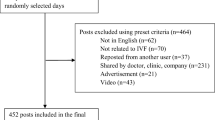Abstract
Objective
To assess women’s knowledge, patient experience, and treatment decision making regarding overactive bladder (OAB) using digital ethnography.
Methods
Online posts were identified using a data mining service. Two hundred randomized posts were reviewed and coded using grounded theory. We then applied a latent Dirichlet allocation (LDA) probabilistic topic modeling process to review the entire collection of identified posts.
Results
A total of 2618 posts by 1867 unique users from 203 different websites were identified. Our analysis yielded six themes: the impact of OAB on quality of life, patient-physician interactions, online engagement, symptom management, patient knowledge acquisition, and alternative therapies.
Conclusion
Overall, online communities are a source of support for women to self-manage the OAB symptom complex and help overcome treatment pathway challenges. Digital ethnography provides insight into patient knowledge and barriers to patient-centered care, which are important to improve patient outreach. Additionally, we identify similar findings to prior work, indicating the reliability of studying social media.
Similar content being viewed by others

References
Haylen BT, De Ridder D, Freeman RM, et al. An International Urogynecological Association (IUGA)/International Continence Society (ICS) joint report on the terminology for female pelvic floor dysfunction. Neurourol Urodyn. 2010;29:4–20. https://doi.org/10.1002/nau.20798.
Stewart WF, Van Rooyen JB, Cundiff GW, et al. Prevalence and burden of overactive bladder in the United States. World J Urol. 2003;20:327–36. https://doi.org/10.1007/s00345-002-0301-4.
Ganz ML, Smalarz AM, Krupski TL, et al. Economic costs of overactive bladder in the United States. Urology 75:526-532.e18. 2010. https://doi.org/10.1016/j.urology.2009.06.096.
Coyne KS, Sexton CC, Thompson CL, et al. Impact of overactive bladder on work productivity. Urology. 2012;80:97–103. https://doi.org/10.1016/j.urology.2012.03.039.
Nitti VW. Clinical impact of overactive bladder. Rev Urol. 2002;4(Suppl 4):S2–6.
Coyne KS, Sexton CC, Irwin DE, et al. The impact of overactive bladder, incontinence and other lower urinary tract symptoms on quality of life, work productivity, sexuality and emotional well-being in men and women: results from the EPIC study. BJU Int. 2008;101:1388–95. https://doi.org/10.1111/j.1464-410X.2008.07601.x.
Anger JT, Nissim HA, Le TX, et al. Women’s experience with severe overactive bladder symptoms and treatment: insight revealed from patient focus groups. Neurourol Urodyn 30:n/a-n/a. 2011. https://doi.org/10.1002/nau.21004.
Smith AL, Nissim HA, Le TX, et al. Misconceptions and miscommunication among aging women with overactive bladder symptoms. Urology. 2011;77:55–9. https://doi.org/10.1016/j.urology.2010.07.460.
Davenport A, Stark S, Quian A, et al. A patient-centered approach to refractory overactive bladder and barriers to third-line therapy. Obstet Gynecol. 2019;134:141–8. https://doi.org/10.1097/AOG.0000000000003320.
Gonzalez G, Vaculik K, Khalil C, et al. Women’s experience with stress urinary incontinence: insights from social media analytics. J Urol. 2020;203:962–8. https://doi.org/10.1097/ju.0000000000000706.
Garcia AC, Standlee AI, Bechkoff J, Cui Y. Ethnographic approaches to the internet and computer-mediated communication. J Contemp Ethnogr. 2009;38:52–84. https://doi.org/10.1177/0891241607310839.
Fox S, Duggan M. Health online 2013. Available at: https://www.pewresearch.org/internet/2013/01/15/health-online-2013/.Retrieved 1 Oct 2020.
Harlow BL, Bavendam TG, Palmer MH, Brubaker L, Burgio KL, Lukacz ES, et al. The prevention of lower urinary tract symptoms (PLUS) research consortium: a transdisciplinary approach toward promoting bladder health and preventing lower urinary tract symptoms in women across the life course. J Women’s Health. 2018;27(3):283–9.
Charmaz K. The grounded theory method: an explication and interpretation. In: Emerson RM, editor. Contemporary filed research. Boston, Ma: Little Brown; 1983. p. 109–27.
Campbell JC, Hindle A, Stroulia E. Latent Dirichlet allocation: extracting topics from software engineering data. Art Sci Anal Softw Data. 2015;3:139–59. https://doi.org/10.1016/B978-0-12-411519-4.00006-9.
van Uden-Kraan CF, Drossaert CHC, Taal E, et al. Empowering processes and outcomes of participation in online support groups for patients with breast cancer, arthritis, or fibromyalgia. Qual Health Res. 2008;18:405–17. https://doi.org/10.1177/1049732307313429.
Gormley EA, Lightner DJ, Burgio KL, et al. Diagnosis and treatment of overactive bladder (non-neurogenic) in adults: AUA/SUFU guideline. J Urol. 2012;188:2455–63. https://doi.org/10.1016/j.juro.2012.09.079.
Coyne KS, Margolis MK, Jumadilova Z, et al. Overactive bladder and women’s sexual health: what is the impact? J Sex Med. 2007;4:656–66. https://doi.org/10.1111/j.1743-6109.2007.00493.x.
Forde JC, Davila JL, Marks BK, et al. Urogynecological conditions associated with overactive bladder symptoms in women. Can Urol Assoc J. 2017;11:E83–7. https://doi.org/10.5489/cuaj.3962.
Abrams P, Hanno P, Wein A. Overactive bladder and painful bladder syndrome: there need not be confusion. Neurourol Urodyn. 2005;24(2):149–50. https://doi.org/10.1002/nau.20082.
Ackerman AL, Lai HH, Parameshwar PS, et al. Symptomatic overlap in overactive bladder and interstitial cystitis/bladder pain syndrome: development of a new algorithm. BJU Int. 2019;123:682–93. https://doi.org/10.1111/bju.14568.
Funding
This study was funded by a pilot grant from the NIDDK Prevention of Lower Urinary Tract Symptoms (PLUS) Research Consortium (JTA, BS).
Author information
Authors and Affiliations
Contributions
G Gonzalez: project development, data analysis/collection, manuscript writing.
K Vaculik: data analysis/collection, manuscript writing.
C Khalil: data analysis/collection, manuscript writing.
Y Zekster: project development, manuscript writing.
C Arnold: project development, data analysis/collection, manuscript writing.
CV Almario: project development, data analysis/collection, manuscript writing.
B Spiegel: project development, data analysis/collection.
JT Anger: project development, data analysis/collection, manuscript writing.
Ethics declarations
Conflicts of interest
Dr. Jennifer T. Anger is an expert witness for Boston Scientific and advisory board member for Axonics. All other authors report no disclosures.
Additional information
Publisher’s note
Springer Nature remains neutral with regard to jurisdictional claims in published maps and institutional affiliations.
Appendices
Appendix 1
Appendix 2
Rights and permissions
About this article
Cite this article
Gonzalez, G., Vaculik, K., Khalil, C. et al. Social media analytics of overactive bladder posts: what do patients know and want to know?. Int Urogynecol J 32, 2729–2736 (2021). https://doi.org/10.1007/s00192-021-04686-1
Received:
Accepted:
Published:
Issue Date:
DOI: https://doi.org/10.1007/s00192-021-04686-1



